The Thin Insulation Market is estimated to be valued at USD 2.6 billion in 2025 and is projected to reach USD 4.3 billion by 2035, registering a compound annual growth rate (CAGR) of 5.2% over the forecast period.
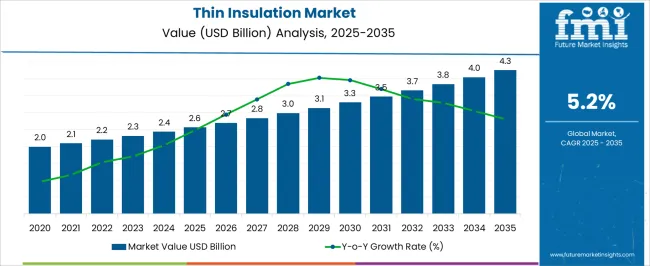
| Metric | Value |
|---|---|
| Thin Insulation Market Estimated Value in (2025 E) | USD 2.6 billion |
| Thin Insulation Market Forecast Value in (2035 F) | USD 4.3 billion |
| Forecast CAGR (2025 to 2035) | 5.2% |
The Thin Insulation market is experiencing steady growth, driven by increasing demand for energy-efficient and space-saving insulation solutions across multiple industries. In both developed and emerging markets, the focus on reducing energy consumption in buildings, improving thermal performance, and minimizing material use has heightened the adoption of thin insulation products. Technological advancements in high-performance foams and aerogel-based materials have enhanced thermal conductivity, durability, and fire resistance, further supporting market expansion.
The rising emphasis on sustainable construction practices, compliance with building energy codes, and incentives for green infrastructure are shaping the market outlook positively. Additionally, urbanization and infrastructure development projects are creating opportunities for the integration of advanced insulation solutions into both residential and commercial buildings.
The market is also benefiting from innovation in installation techniques that reduce labor costs and facilitate retrofitting, making thin insulation more accessible As energy efficiency standards become increasingly stringent and material performance expectations rise, the Thin Insulation market is positioned to sustain growth, driven by continuous product innovation and broadening applications.
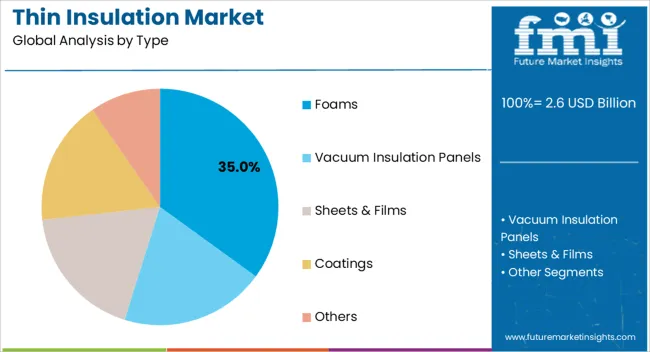
The Foams type segment is projected to hold 35.0% of the Thin Insulation market revenue share in 2025, establishing it as the leading product type. This dominance is being attributed to the versatility, lightweight properties, and high thermal resistance offered by foam-based materials. The segment’s growth has been driven by its ability to deliver consistent performance in both new construction and retrofitting projects, where space-saving and thermal efficiency are critical.
Foam insulation is increasingly preferred due to its ease of handling, rapid installation, and compatibility with various substrates. Additionally, advancements in closed-cell foam technologies have enhanced moisture resistance and structural stability, expanding their application in diverse environmental conditions.
The cost-effectiveness of foams compared to alternative insulation solutions has also encouraged wider adoption across industrial and residential sectors The ongoing demand for energy-efficient buildings and compliance with evolving building regulations has reinforced the leadership of this segment, and continued innovation in foam materials is expected to sustain its market prominence.
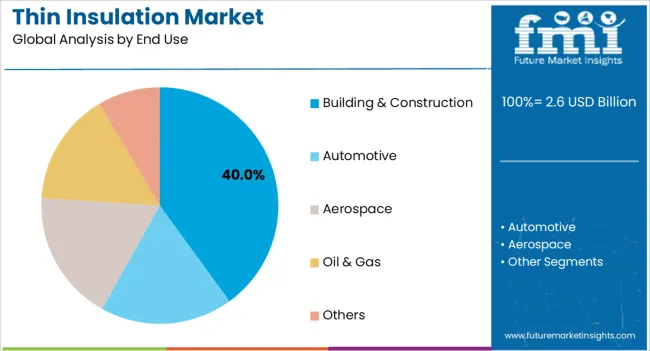
The Building and Construction end-use segment is anticipated to account for 40.0% of the Thin Insulation market revenue in 2025, making it the largest consumer of thin insulation products. This segment’s leadership is being driven by the rising need for energy-efficient construction materials and compliance with increasingly strict thermal performance standards in both commercial and residential buildings. Thin insulation is being widely adopted in walls, roofs, floors, and facades to maximize usable space while maintaining high insulation performance.
The ease of integrating these materials into modern construction designs and the ability to retrofit existing structures have further propelled growth. In addition, the construction sector is benefiting from reduced labor and transportation costs associated with lightweight and flexible insulation materials.
The expansion of urban infrastructure projects and the focus on sustainable building practices are creating long-term demand for high-performance thin insulation solutions Continued emphasis on reducing energy consumption and improving building envelope efficiency is expected to maintain the growth momentum of the Building and Construction segment.
Between 2020 and 2025, the thin insulation industry experienced tremendous expansion and advancement. During this time, there was an increasing emphasis on energy efficiency in construction, as well as a growing demand for environment-friendly building materials.
Due to their better thermal performance and space-saving benefits, thin insulation materials such as aerogel and vacuum insulation panels have gained popularity.
The thin insulation business expanded even fast between 2025 and 2035. Technological advancements resulted in the creation of highly efficient and cost-effective thin insulation systems, enabling great usage across a variety of industries.
Moreover, the rising awareness of climate change and severe construction codes boosted demand for thin insulation solutions, resulting in a thriving market throughout this period.
In recent years, the construction and building industry has witnessed a growing need for highly effective insulation services, leading to a significant rise in the market share for thin insulations. Further, thin insulation materials have become widely popular in the industry due to their ability to provide excellent thermal insulation while addressing common space constraints.
The expansion of infrastructure, corporate buildings, residential complexes, and other construction activities, driven by rapid urbanization, has contributed to the increased demand for thin insulation materials in the market.
Thin insulation materials offer numerous advantages across various building applications, but they hold particular importance in retrofit projects where additional insulation is often limited. Among the promising techniques in this domain are vacuum insulation panels and lightweight silica aerogel. Certain companies now provide flexible insulation materials with an impressive thermal resistance of up to R-10 per inch.
The use of these insulating materials has primarily been restricted to industrial applications like pipes, there is ongoing exploration of their potential in building projects. As the construction industry continues to prioritize energy efficiency and sustainable building practices, the demand for thin insulation materials is projected to grow further.
The ongoing advancements in material technology and a deep understanding of their benefits are expected to pave the way for wider adoption and integration of thin insulations into building designs, thereby fueling the expansion of the market in the coming years.
The market share for thin insulation has been severely challenged due to growing environmental concerns surrounding the overuse of plastic. Plastics, being non-biodegradable and environmentally harmful, have faced restrictions and limitations imposed by governments on the production and sale of expanded polystyrene, a common plastic-based thin insulation material.
Insulation materials are made from various sources such as sand, petrochemicals, and recycled materials like old newspapers, the negative impacts of resource depletion and mining pollution cannot be ignored. Despite their thermally efficient nature and ease of installation, plastic insulation materials have faced scrutiny due to their environmental consequences.
The long-term energy savings and durability offered by plastic insulation have contributed to its market share. But the growing environmental side effects pose a significant challenge to the overall thin insulation market.
| Attributes | Details |
|---|---|
| Top Type | Foams |
| CAGR % 2020 to 2025 | 6.6% |
| CAGR % 2025 to End of Forecast (2035) | 5.4% |
Foams, as a versatile and frequently utilized type of thin insulating material, lead the market for a variety of reasons. Foams have great thermal insulation capabilities and are resistant to both heat and cold.
Because foams are lightweight and easy to handle, they are suited for a wide range of applications and installation techniques. Since foams are flexible, they can conform to uneven surfaces and fill gaps effectively.
Foams can be created in a variety of densities and thicknesses, allowing for customization for specific project requirements. Also, foams are less expensive than other types of thin insulation materials, making them a popular choice for many industries and construction projects, contributing to their market dominance.
| Attributes | Details |
|---|---|
| Top End Use | Automotive |
| CAGR % 2020 to 2025 | 6.6% |
| CAGR % 2025 to End of Forecast (2035) | 5.4% |
The automotive segment leads in the thin insulation market among other end-user segments due to several factors. Automotive manufacturers are increasingly focused on improving fuel efficiency and reducing emissions in vehicles. Also, thin insulation materials help achieve these goals by providing effective thermal insulation, minimizing heat transfer, and enhancing energy efficiency in automotive applications.
The automotive industry is subject to stringent regulations and standards related to vehicle emissions and energy efficiency. Thin insulation materials offer a lightweight and space-saving solution, allowing automakers to meet these regulations without compromising on performance or safety.
The automotive sector experiences high demand, accelerating the need for efficient insulation materials to enhance passenger comfort, reduce noise, and protect sensitive components from extreme temperatures. Thin insulation provides these benefits while also contributing to weight reduction, which improves overall vehicle performance.
Considering these factors, the automotive industry leads in the adoption of thin insulation, benefiting from its energy-saving properties, regulatory compliance, and enhanced vehicle performance.
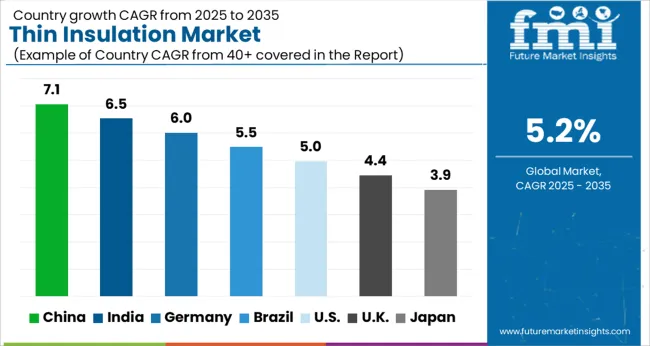
| Attributes | Details |
|---|---|
| The United States Market Size by End of Forecast Period (2035) | USD 734.4 million |
| The United States Market Absolute Dollar Growth | USD 303.1 million |
| CAGR % 2020 to 2025 | 6.5% |
| CAGR % 2025 to 2035 | 5.5% |
The United States’ thin insulation market is experiencing significant growth driven by several factors. The increasing focus on energy efficiency and sustainability in the construction industry has fueled the demand for thin insulation materials. Additionally, Stringent building codes and regulations aimed at reducing energy consumption have further accelerated market growth.
The automotive and aerospace sectors also contribute to the market expansion with the adoption of thin insulation materials for thermal management and lightweight purposes.
Moreover, technological advancements in thin insulation materials, such as aerogels and vacuum insulation panels, have enhanced their performance and attractiveness in the market. Overall, the United States’ thin insulation market is poised for continued growth in the coming years.
| Attributes | Details |
|---|---|
| The United Kingdom Market Size by 2035 | USD 156.8 million |
| The United Kingdom Market Absolute Dollar Growth | USD 63.1 million |
| CAGR % 2020 to 2025 | 6.1% |
| CAGR % 2025 to 2035 | 5.3% |
The United Kingdom thin insulation market is experiencing notable growth driven by various factors. The government's commitment to reducing carbon emissions and achieving energy efficiency targets has propelled the demand for thin insulation materials. Building regulations and policies encouraging energy-efficient construction have further stimulated market growth.
The construction sector, including both residential and commercial projects, is a significant end-user of thin insulation materials in the United Kingdom. The automotive industry's emphasis on lightweight and thermal management has contributed to the market expansion.
Technological advancements and innovations in thin insulation materials have improved their performance and appeal. Overall, the United Kingdom thin insulation market is poised for continued growth as energy efficiency remains a top priority.
| Attributes | Details |
|---|---|
| China Market Size by 2035 | USD 869.8 million |
| China Market Absolute Dollar Growth | USD 356.7 million |
| CAGR % 2020 to 2025 | 6.4% |
| CAGR % 2025 to 2035 | 5.4% |
Construction Industry Expansion
The Asia Pacific construction sector is expanding significantly, owing to rising urbanization, infrastructural expansion, and increased investment in residential and commercial buildings. Further, thin insulation materials are widely employed to improve energy efficiency and reduce heat transmission in buildings, boosting market demand.
Regulations on Energy Efficiency
Energy efficiency policies and standards are being implemented by governments around the Asia Pacific area to minimize carbon emissions and promote sustainable development. Moreover, thin insulating materials play an important role in achieving these requirements, which has led to their expanded acceptance in a variety of industries.
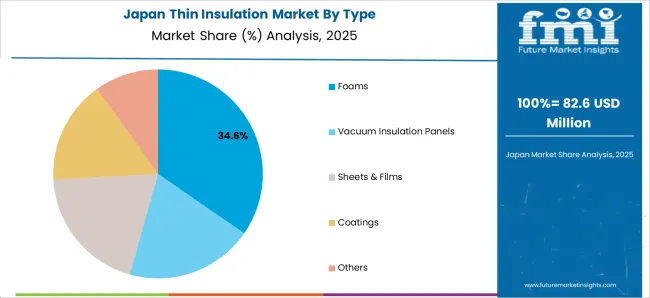
| Attributes | Details |
|---|---|
| Japan Market Size by 2035 | USD 770.2 million |
| Japan Market Absolute Dollar Growth | USD 316.6 million |
| CAGR % 2020 to 2025 | 6.4% |
| CAGR % 2025 to 2035 | 5.4% |
Increasing Energy Conservation Awareness
The growing awareness of the need for energy conservation and environment-friendly activities is driving the market for thin-insulating products. Consumers are becoming aware of the importance of decreasing energy use and choosing energy-efficient alternatives, such as thin insulating materials.
Industrial Development
The Asia Pacific region is witnessing strong industrial expansion, particularly in manufacturing, automotive, and electronics. Insulation materials are frequently required in these industries to increase energy efficiency, temperature management, and noise levels. Further, thin insulation products are popular due to their lightweight and high performance.
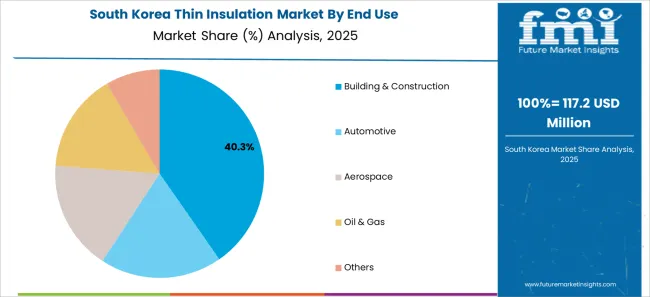
| Attributes | Details |
|---|---|
| South Korea Market Size by 2035 | USD 207.6 million |
| South Korea Market Absolute Dollar Growth | USD 79.9 million |
| CAGR % 2020 to 2025 | 5.9% |
| CAGR % 2025 to 2035 | 5.0% |
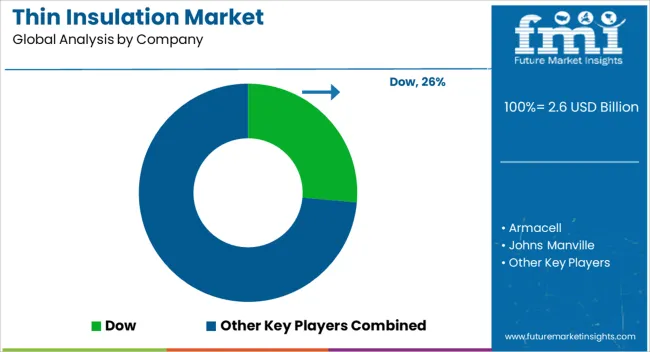
The competition in the thin insulation market is fierce and continuously evolving. With the growing emphasis on energy efficiency and sustainability, there is a heightened demand for high-performance insulation solutions.
Numerous companies are actively competing to offer innovative thin insulation materials that provide effective thermal resistance while minimizing thickness.
Additionally, established players in the industry are investing in research and development to enhance their product offerings and maintain their market share. At the same time, new entrants are introducing disruptive technologies and materials, intensifying the competition further.
Companies are focusing on factors such as cost-effectiveness, ease of installation, environmental impact, and compliance with regulatory standards. Overall, the thin insulation market remains highly competitive, driven by technological advancements and customer demands.
Key Players Profiled in the Global Market
Key Developments
The global thin insulation market is estimated to be valued at USD 2.6 billion in 2025.
The market size for the thin insulation market is projected to reach USD 4.3 billion by 2035.
The thin insulation market is expected to grow at a 5.2% CAGR between 2025 and 2035.
The key product types in thin insulation market are foams, vacuum insulation panels, sheets & films, coatings and others.
In terms of end use, building & construction segment to command 40.0% share in the thin insulation market in 2025.






Full Research Suite comprises of:
Market outlook & trends analysis
Interviews & case studies
Strategic recommendations
Vendor profiles & capabilities analysis
5-year forecasts
8 regions and 60+ country-level data splits
Market segment data splits
12 months of continuous data updates
DELIVERED AS:
PDF EXCEL ONLINE
Thin Film Coatings Market Size and Share Forecast Outlook 2025 to 2035
Thin-film Platinum Resistance Market Size and Share Forecast Outlook 2025 to 2035
Thin Film Platinum Resistance Temperature Sensor Market Size and Share Forecast Outlook 2025 to 2035
Thin Film Solar Cells Market Size and Share Forecast Outlook 2025 to 2035
Thin Film Photovoltaics Market Size and Share Forecast Outlook 2025 to 2035
Thin Wall Packaging Market Size and Share Forecast Outlook 2025 to 2035
Thin Wafer Processing and Dicing Equipment Market Size and Share Forecast Outlook 2025 to 2035
Thin Film Solar PV Backsheet Market Size and Share Forecast Outlook 2025 to 2035
Thin Film Encapsulation TFE Market Size and Share Forecast Outlook 2025 to 2035
Thin Wall Plastic Container Market Analysis - Size, Share, and Forecast 2025 to 2035
Thin Film Battery Market Size and Share Forecast Outlook 2025 to 2035
Thinned Starch Market Size, Growth, and Forecast for 2025 to 2035
Thin Film and Printed Batteries Market Trends - Growth & Forecast 2025 to 2035
Thin Wafers Market Analysis - Size, Demand & Growth 2025 to 2035
Market Share Breakdown of Thin Wall Plastic Container Providers
Thin Client Market
Thin Paper Market
Thin Wall Mould Market
Thin Wall Glass Container Market
Thin Film Photovoltaic Modules Market

Thank you!
You will receive an email from our Business Development Manager. Please be sure to check your SPAM/JUNK folder too.
Chat With
MaRIA